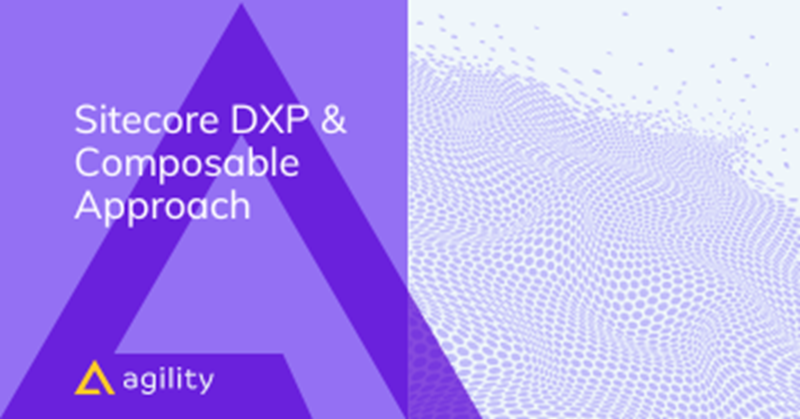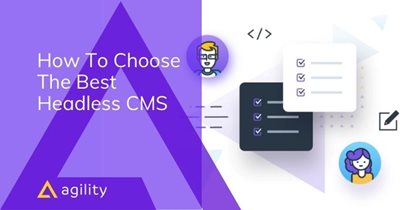Sitecore's Composable DXP

When the decision-makers enterprise company weighs up their options for an enterprise-grade CMS, one of the platforms on the list will likely be Sitecore. A leading CMS in the digital experience industry, Sitecore’s suite of products has been the go-to option for several businesses.
However, businesses that previously opted for a monolithic suite have recognized that they need more freedom and flexibility and that Sitecore’s all-in-one solution can no longer fit their needs.
Interestingly enough, Sitecore themselves have been recently championing the alternatives to their monolithic approach, such as composable DXPs and MACH architecture. The problem is the way they’re going about it doesn’t seem to provide enterprises with the speed and adaptability they need. Any businesses considering Sitecore as a composable DXP may need to read the fine print and will likely find a flexible headless CMS a better option.
Sitecore’s Move Towards Composability
Sitecore has been on the acquisition charge lately in an attempt to position itself as a composable DXP. Customer data platform Boxever, eCommerce order management system Four 51, marketing automation platform Moosend and AI-search platform Reflektion have been added to the suite of products Sitecore offers.
Following the acquisitions and integration of the products into the Sitecore suite, Sitecore has stated that these additions are fundamental to “expanding Sitecore’s SaaS-enabled composable DXP.” Aside from these acquisitions, Sitecore has also been championing the MACH architectural principles for building software stacks, including Microservices, API-first, Cloud-native, and Headless.

The problem with Sitecore’s interpretation of both composable DXP and MACH is that until now, Sitecore has only succeeded in adding more products to an already bloated suite. On the other hand, the concept of MACH includes a microservices-based system not a tightly coupled suite. Not to mention, the notion of a composable DXP allows businesses to simply choose the tools they want to include and not be expected to select the ones offered by the vendor.
Is Sitecore MACH Ready?
While Sitecore has highlighted the importance the businesses are placing on the ability to choose the best tools for their needs and the flexibility to change those needs, it still falls short of being a MACH-ready platform. Here’s why:
Sitecore’s Traditional Monolithic Approach
Sitecore is a platform that can be classified as a monolithic DXP. It offers an all-in-one suite containing the features most enterprises will need, from the CMS and eCommerce solution to digital asset management, personalization tools, and more.
At its core, Sitecore is still built using this monolithic architecture which tightly couples all of the tools in the system together. While this may be a good option for some businesses that just want to set it and forget it when it comes to their CMS, it severely restricts most other companies and definitely can’t be considered MACH or composable.
The Growing Suite Problem
Sitecore now offers nearly ten products as part of their suite with the latest acquisitions and products. By expanding the suite, customers now have to shoulder the additional burden of even more tools they probably won’t use or that don’t fit into their existing systems. If they already have another DAM solution or personalization tool, they need to decide whether to keep using it or eat the additional costs of Sitecore’s expanded suite.
In addition, by spending millions of dollars on acquisitions, Sitecore’s strategy could be that despite becoming a composable DXP, they might not offer the true flexibility required to integrate with just any tool.
Limited Flexibility and User-friendliness
Sitecore, despite its popularity, has also been noted to have other issues with its platform, including an architecture that hinders user experience, limited documentation, a long and difficult learning curve, expensive pricing, and the need to rely on technical teams. Many of these features still remain and go against the ethos of what it means to be a MACH-ready composable DXP.
Read More: What Is Sitecore CMS and Its Competitors?
Characteristics of a Composable DXP

For a platform to be considered a true composable DXP, it should have the following characteristics. Here's why a hybrid headless CMS should sit at the center:
Future-proof Architecture
With a future-proof architecture, the platform you choose doesn’t need to be constantly swapped out when something new comes along. With Sitecore’s bulky suite, you can find yourself locked into a situation that makes change difficult. There is the possibility that they may enable customers to swap out components in the future, but that future is still a few years away due to the pre-existing architecture.
Whereas with a composable DXP that has a hybrid headless CMS at the center, new technologies, tools, and frameworks can be adopted without any issue.
User-friendly Interfaces
Marketers using a composable DXP shouldn’t be handicapped by limited content editing features or restrictive content modeling. Instead, a hybrid headless CMS and true composable DXP provides access to the features they need, such as the WYSIWYG editing and previews that make creating experiences easier. However, in Sitecore’s case, it is known for having a very technical user experience with a steep learning curve.
Extensible APIs
Finally, a composable DXP needs APIs that enable businesses to integrate new technologies without worrying about vendor lock-in. A hybrid headless CMS provides the extensible APIs that simplify adding more functionality. This allows your business to select the best tools and vendors to appeal to your customers. However, with Sitecore, any integrations you make will need to fit into an already cumbersome suite system.
Read More: DXP, Composable DXP, and MACH Explained
Benefits of Composable DXP

By adopting a true composable DXP, organizations can realize quite a few benefits:
Removal of Content Silos
With a composable DXP you can remove content silos that plague many organizations. Instead you can take advantage of pre-built workflows that help streamline content production and make collaboration easier across departments.
Faster Time to Market
A composable DXP increases your agility, enabling your organization to realize a faster time to market when adopting new tools and technologies as well as releasing marketing campaigns. With platforms like Sitecore on the other hand, extensive training or vendor-specific expertise is required which can slow you down.
Flexible Experiences
Creating engaging customer experiences across multiple channels is also much easier with a composable DXP. Organizations can deliver content to any digital touchpoint as well as integrate analytics, personalization and CRM tools to provide data that enhances the experience even further.
Agility CMS: A Headless CMS Built With MACH Architecture

Enterprises need the best-of-breed benefits that a composable DXP offers and the architectural support of MACH. However, Sitecore’s current attempt comes up short. Agility CMS’ API-first headless CMS offers the freedom and flexibility that developers love with a headless CMS, as well as the marketer-friendly functionality and authoring tools that marketers need.
Hybrid DXP: Agility CMS offers all of the benefits of a composable DXP, but it goes a step further by including pre-built integrations with best-in-class tools that enable streamlined development and faster time to market.
Content-first: Agility CMS’ content-first approach places content at the forefront of any project. While other headless CMS platforms may forget the importance of content management, Agility CMS has the content architecture, relationships, and definitions that enable you to provide the right content at the right time to your audience.
Page Management: Agility CMS makes it easy for marketers to work with content pages and not rely on developers. Editors have access to built-in SEO fields to optimize content and can compose content on each page using page modules.
Pre-built Integrations: The Agility CMS marketplace features pre-built integrations with tools like HubSpot, Netlify, Cloudinary, Algolia, Formstack, and other top-rated vendors.
If you’re looking for a platform to place at the center of your composable DXP while you add other tools around it then read our whitepaper: Your Ultimate 50-Point Checklist for Choosing a Headless CMS.


Recommended for You

How To Choose The Best Headless CMS For Your Brand
Ready to move off Sitecore?
Want to discover a true composable DXP? Let's talk Agility CMS!
